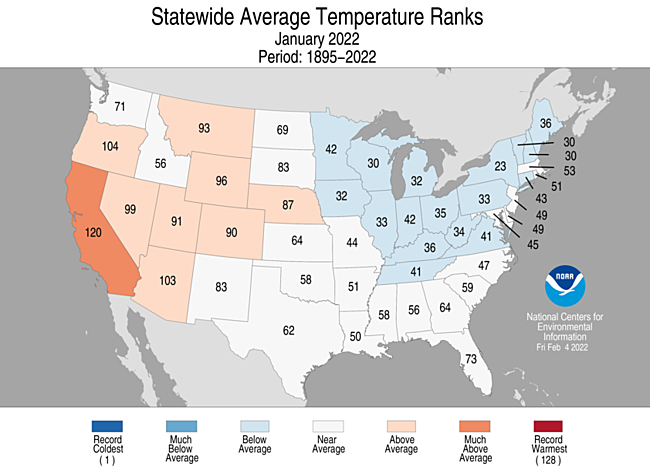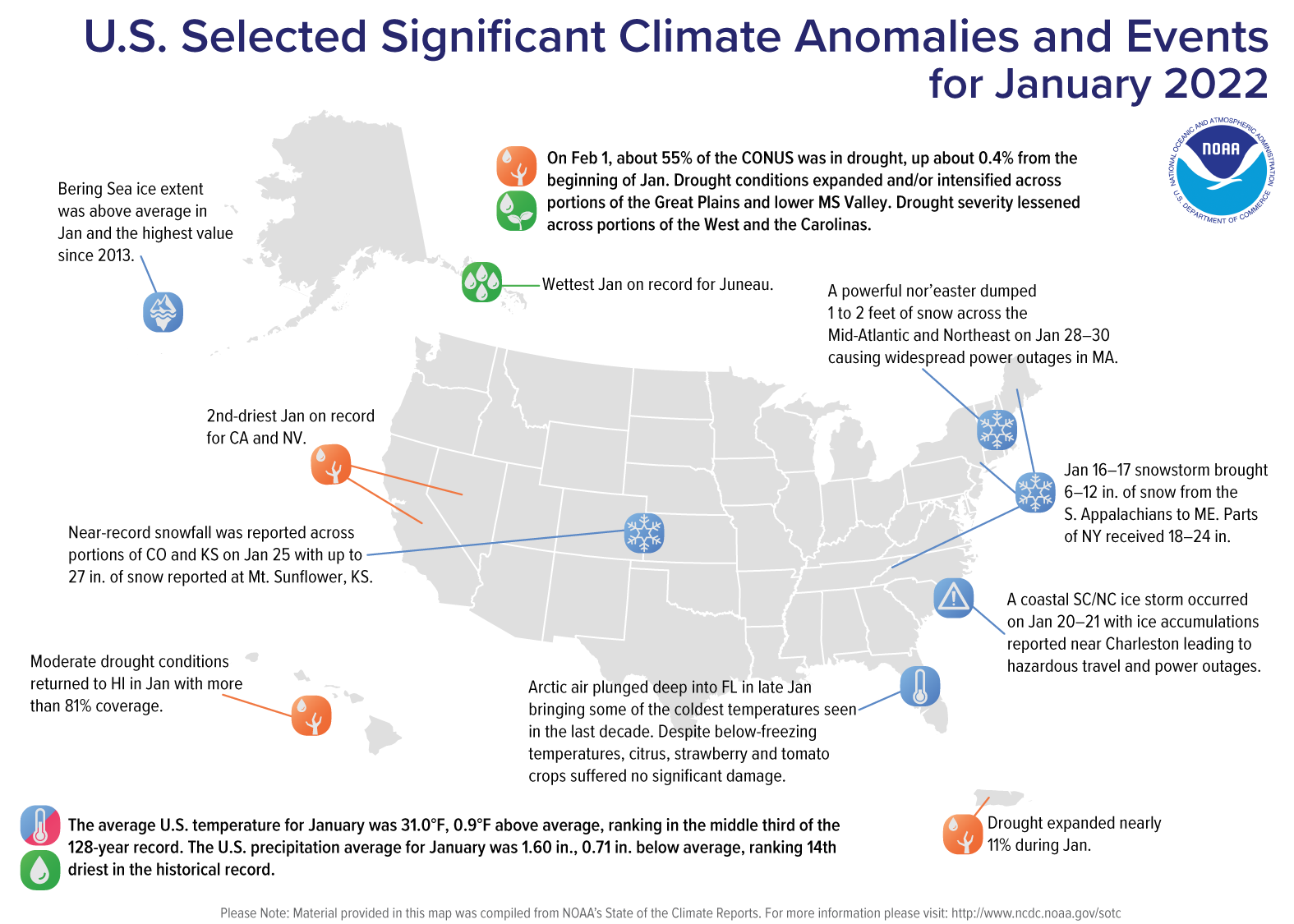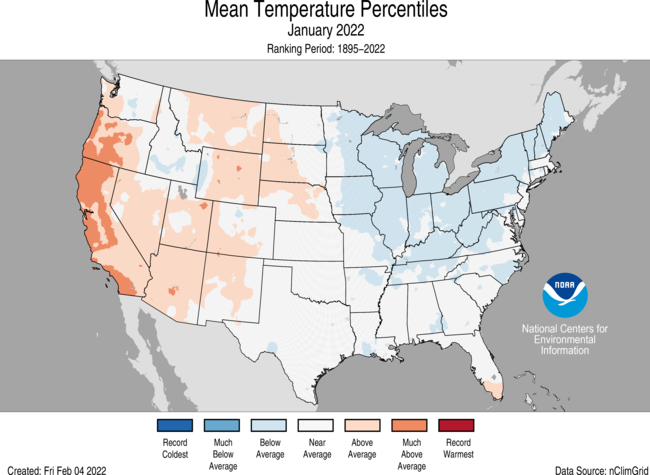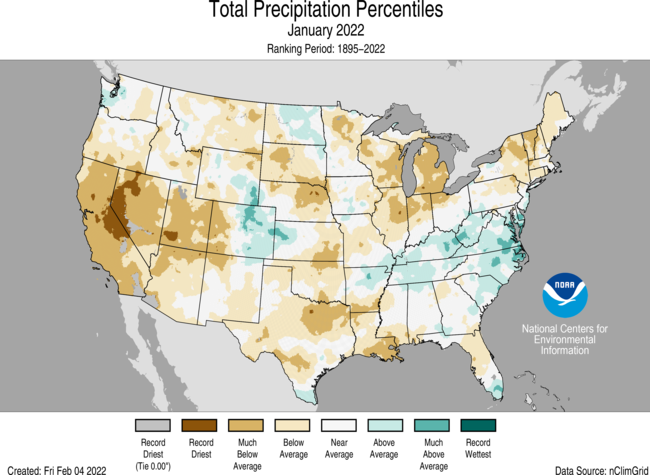The main purpose of this ongoing blog will be to track planetary extreme, or record temperatures related to climate change. Any reports I see of ETs will be listed below the main topic of the day. I’ll refer to extreme or record temperatures as ETs (not extraterrestrials).😉
Main Topic: Early February Record Scoreboard and Climatological Review
Dear Diary. It’s time once again for our monthly climatological review. Here on this site, we present monthly summaries near the 8th of each month, and each is available if you want to go back through my Extreme Temperature Diary archive under my “Record Scoreboard Climatological Reviews” category (located on the upper left-hand corner of my home page):
https://guyonclimate.com/category/record-scoreboard-climatological-reviews/
I’m repeating my mantra from prior months:
January 2022 was near average temperature wise and got ranked by the National Center for Environmental Information as warmest for the lower 48 states, or 67th coldest and 62nd warmest since records began being kept in 1895:
https://www.ncdc.noaa.gov/cag/national/rankings
This map holds few surprises. Above average temperatures were experienced in the West with below average conditions in eastern states:

Brief summary for January 2022: Most reports of record warmth came from the tail end of a historic December warm wave that spilled over into the new year across the South. Most of the reports of record chill came from the Plains. January 2022 marks the 8th consecutive month of more DHMX than DLMN records across the United States.
Here are my two U.S. Daily Record Scoreboards updated through 2/06/2022 (data compiled from the following NCEI site):
https://www.ncdc.noaa.gov/cdo-web/datatools/records


DHMX= Daily High Max Reports. DLMN= Daily Low Min Reports. DHMN= Daily High Min Reports. DLMX=Daily Low Max Reports.
For these data sets all monthly ratios of > 10 to 1 DHMX to DLMN or > 10 to 1 DLMN to DHMX are in bold type. The rankings are for the lower 48 states with the warmest ranking since 1895 of average temperatures being 127 and 1 being the coldest as of 2021. Blue colors represent cold months and red warm. Those months and years with counts close to a 1 to 1 ratio of highs to lows are colored black. Boldly colored months, such as December 2021, have ratios of more than 10 to 1 daily record highs to lows or lows to highs, and are either historically hot or cold, most of which have made news.
January 2022 had approximately a 1.8 to 1 ratio of record DHMX to DLMN individual record counts, so the color I used for this month was bold, dark red on the top chart.
January 2022 had approximately a 2.2 to 1 ratio of record DHMN to DLMX individual record counts, so the color I used for this month was red on the bottom chart.
Due to climate change, we are seeing fewer blue colors on these Record Scoreboards with time, and February 2021 certainly fit this trend.
As stated, the ranking for January 2022 was 67, which was colored black. I color rankings of +10 or -10 from the average ranking of 63.5 black, indicating that these are near average temperature wise. Record statistics were a bit on the warm side compared with the ranking of 67 for December 2021. This is probably due to a cold, below average temperature, weather regime that set up over the Midwest during the month, but it wasn’t intense enough to produce many cold records.
Will February 2022 be the ninth consecutive warmer than average month in which record heat exceeds record chill? As shown on both record scoreboard charts, we can see that February 2022 has gotten off to a chilly start, but there have not been that many record reports. I expect February 2022 to be slightly above average, as a whole, but the month probably won’t be in the top twenty rankings looking at meteorological models.
Here is much more detailed climatology for January 2022 as complied by NOAA:
https://www.ncei.noaa.gov/news/national-climate-202201
Assessing the U.S. Climate in January 2022
Nor’easter brought blizzard conditions, significant snowfall to Northeast

During January, the average contiguous U.S. temperature was 31.0°F, 0.9°F above the 20th-century average, ranking in the middle third of the 128-year record and was the coolest January since 2014.
The January precipitation total for the contiguous U.S. was 1.60 inches, 0.71 inch below average, and tied with 2009 for 14th driest in the 128-year period of record. This was the driest January since 2014.
A type of nor’easter known as a bomb cyclone, or a rapidly intensifying low pressure system, developed over the Atlantic Ocean along the East Coast on January 28-30 and brought 1 to 2 feet of snow and blizzard conditions along the coastline from Delaware to Maine. This event was classified as a Category 1 snowstorm, considered “Notable” on the Regional Snowfall Index (RSI) scale. On January 29, Boston tied its greatest 1-day snowfall total — 23.6 inches.

This monthly summary from NOAA National Centers for Environmental Information is part of the suite of climate services NOAA provides to government, business, academia and the public to support informed decision-making.
January
Temperature

- Temperatures were above average across much of the West and parts of the northern Plains. California had its ninth-warmest January on record. Temperatures were below average from the Midwest and Tennessee Valley to the Northeast and were associated with a persistent trough of low pressure across the region.
- The Alaska average January temperature was 3.9°F, 1.7°F above the long-term mean, ranking in the middle third of the 98-year record. Temperatures across the state were fairly mild during January with above-average temperatures observed across portions of Cook Inlet and the Southeast Interior regions.
- Mild January temperatures contributed to a monthly average Bering Sea Ice extent that was double the record-low value set in 2018 and the highest value since 2013.
Precipitation

- Precipitation was above average across portions of the Colorado High Plains, northern Plains, Tennessee Valley and Mid-Atlantic. Precipitation was below average across most of the Lower 48. Regions with below-average precipitation included much of the West, High Plains, Deep South, Great Lakes and Northeast. Nevada and California each had their second-driest January, and Utah experienced its third driest January on record.
- Several significant snow events occurred throughout the month, including the January 4 event that brought a blanket of snow from Arkansas to Delaware and stranded motorists for as long as 24 hours on I-95 in Virginia. A snow event on January 16-17 brought significant snowfall from the southern Appalachians to Maine with portions of New York state reporting 18-24 inches of snow. The nor’easter, which brought heavy snowfall to portions of the Mid-Atlantic and Northeast on January 28-30, intensified at nearly double the rate of a classic bomb cyclone, dropping 35 millibars in an 18-hour period. At least 100,000 people were without power during this storm.
- Alaska ranked in the wettest third of the historical record for January. The North Slope, Southeast Interior, Northeast Gulf and Panhandle regions were wetter than average while the Aleutians received below-average precipitation during January.
- According to the February 1 U.S. Drought Monitor report, approximately 55.2 percent of the contiguous U.S. was in drought, which is up about 0.4 percent from the beginning of January. Drought conditions expanded and/or intensified across portions of the Great Plains and lower Mississippi Valley. Drought severity lessened across portions of the West and the Carolinas. Moderate drought conditions returned to Hawaii in January with more than 81 percent coverage across the islands, while drought expanded nearly 11 percent across Puerto Rico during January.
For more detailed climate information, check out our comprehensive January 2022 U.S. Climate report scheduled for release on February 11, 2022.
Here is some more overseas climatology from January 2022:
Here are some “ET’s” from Tuesday:
Here is more climate and weather news from Tuesday:
(As usual, this will be a fluid post in which more information gets added during the day as it crosses my radar, crediting all who have put it on-line. Items will be archived on this site for posterity. In most instances click on the pictures of each tweet to see each article. The most noteworthy items will be listed first.)
Now here are some of today’s articles and notes on the horrid COVID-19 pandemic:
(If you like these posts and my work please contribute via the PayPal widget, which has recently been added to this site. Thanks in advance for any support.)
Guy Walton “The Climate Guy”